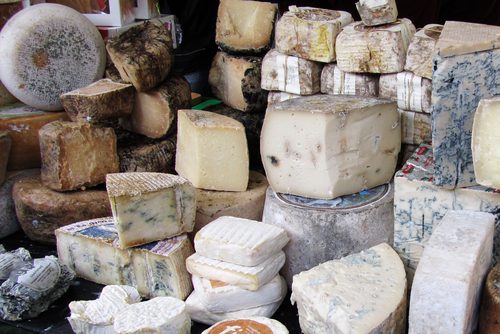Paris In (Cheesy) Context
For Father’s Day, Julie my family gave me a copy of Zola’s novel “The Belly of Paris,” about Les Halles, the historic food market. Here’s a scene from the book (Mark Kurlansky is the translator):
All around her, cheeses were stinking. Huge blocks of butter were lined up on the two shelves at the back of the shop. Brittany butter was overflowing from its baskets. Normandy butters, wrapped in canvas, looked like models of stomachs onto which some sculptor had thrown wet cloths to keep them from drying out. Other blocks, already in use, cut with large knives into jagged rocks with valleys and crevices, looked like landslides on a mountain gilded by the pale evening light of autumn. Under the gray-veined red marble display counter were baskets of chalk white eggs, and in their crates on straw pallets were bondons, end to end, gourneys arranged on a platter like medals, in darker colors with greenish tints. But most of the cheeses were piled up on tables, and there, next to the one-pound packs of butter, was an enormous Cantal cheese on beet greens, looking as if it had been chopped iwth a hatchet, then a golden Chester and a Gruyere that looked like the fallen wheel of a primitive wagon. From Holland there were balls like decapitated heads smeared with dried blood with the hard shell of an empty skull, which has given them the name “tetes-de-mort.”
A Parmesan added an aromatic pungence to the heavy smell. Three Bries on round boards were sad as waning moons. Two very dry ones were full. The third, in its second quarter, was oozing, emitting a white cream that spread into a lake, flooding over the thin boards that had been put there to stem the flow. Port Saluts shaped like ancient discuses had the names of the producers inscribed around the perimeters. A Romantour, wrapped in silver paper, was reminiscent of a nougat bar, a sugary cheese that had strayed into the land of sour fermentation. The Roqueforts, under their glass bells, had a regal bearing, their fat, marbled faces veined in blue and yellow as though they were the victims of some disgraceful disease that strikes wealthy people who eat too many truffles. Alongside them were the goat cheeses, fat as a child’s fist, hard and gray like the stones rams kick down a path when they lead the flock.
And then there were the smells: the pale yellow Mont d’Ors released a sweet fragrance, the Troyes, which were thick and bruised on the edges, were stronger-smelling than the others, adding a fetid edge like a damp cellar; the Camemberts, with their scent of decomposing game; the Neufchatels, the Limbourgs, the Marolles, the Pont l’Eveques, each one playing its own shrill note in a composition that was almost sickening; the Livarots, dyed red, harsh and sulfurous in the throat; and the Olivets, wrapped in walnut leaves the way peasants cover rotting carcasses of animals lying by the side of the road in the heat of the sun with branches.
That’s bracing writing. Can’t you just smell the place?
Julie and the kids also gave me a gift certificate to a gastronomic walking tour of that novel’s setting. Look at this excerpt from the tour description:
Led by cultural historian Carolin Young whose last book,Apples of Gold in Settings of Silver investigated twelve of the greatest feasts in Western history, this walk begins at the Bourse du Commerce, the old commodities exchange, and, prior to that, the wheat market. We will pass the ancient church of Saint-Eustache, built largely with donations given by those who made their fortunes at Les Halles. As we walk, the history of the lost market and Zola’s Belly of Paris will be summarized.
On the newly revitalized rue Montmartre, we will visit several of Paris’s premier kitchenware and pastry-making suppliers, discussing the organization of the classic French kitchen and its role in the local culture. We will stop at old-world shops specializing in foie gras and truffles, visit a bulk spice shop, and pay our respects to one of the city’s premier boulanger/pâtisserie which recently won first prizes for the best butter croissant and galette aux amandes in France.
At a shop selling delicacies from the gastronomically renowned region of Auvergne we will address the importance of terroir. Perusing artisan boulangers, cheese shops, butchers, and fishmongers, we will explore the history of the elite guilds and associations that, since Medieval times and still today, strictly regulate food quality and production in the city.
Can you imagine? Come October, I am so there. That Context Tours is an amazing thing: “scholar-led walking tours of the world’s cultural capitals.” A traveler could go broke on these things. They sound fantastic.


Subscribe for as little as $5/mo to start commenting on Rod’s blog.